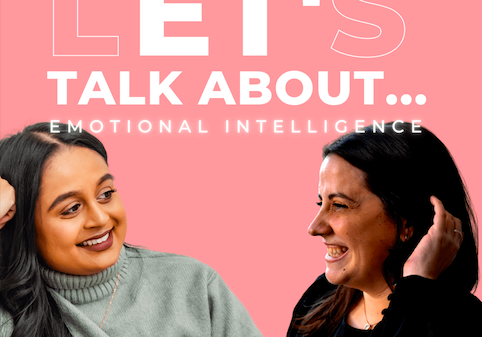On this week’s episode of Let’s Talk About…, Elise sits down with co-host Sarah Joseph to talk about emotions.
Sarah is a certified emotional intelligence coach whose mission is to help you get comfortable with your emotions and master them to live a more purposeful life. She understands how our lack of emotional management can impact the longevity of our relationships and can inspire our emotional healing by plugging into our most powerful tool, the Mind. Her philosophy is that our emotions show up in every aspect of our lives and it’s your right to learn how to manage them effectively to your advantage.
On this week’s episode, Elise and Sarah talk about the neuroscience and purpose of emotions, why we need them, and how they affect our daily lives.
“Overthinking is actually the result of underthinking. We’re actually not thinking about everything that could actually make this also completely rational and reasonable. We’re only sometimes focusing on those negative aspects.” Sarah tells Elise on Let’s Talk About.
Check out or show’s full transcript below.
[00:00:00] Elise: Hi everyone and welcome to season three of Let’s Talk About if you joined us last week, you know that we’re kicking things off with a series on emotional intelligence with my co-host, certified life and emotional intelligence coach, Sarah Joseph. Hi Sarah. Hi, how are you? Hi. I feel like our first episode went great last week and I’m excited to be here again with you this week talking excited, a little bit more about like an introduction to our emotions.
So yeah, we, uh, I love to, when in our first conversation, and for those of you that. Didn’t listen last. We definitely listen. It talks, we talk all about Sarah’s five step process. Sarah was a guest on season two in December, if you wanna go back and listen to that as well. And what I love about Sarah is how she sort of incorporates the science behind emotions and things like of that nature, and we’re gonna get into that a little bit of today as we talk more specifically about our emotions, how they work, what’s the neuroscience behind it, all of that. So I love this shit for lack of better words.
[00:01:06] Sarah: I hear you. This is, this is my jam right here. The science.
[00:01:10] Elise: It’s definitely your jam. You’re totally educated in it. It’s totally your jam. I’m just like, I can’t wait to hear more write there word neuroscience in there and I’m like, I wasn’t even good at science, so I don’t know why I grabbed towards it, but I’m like, tell me the actual data of things and emotions.
Right. So yeah, tell us the, what the science says about how our emotions. . Yeah.
[00:01:33] Sarah: So I’m gonna try my very best not to, you know, overwhelm anyone with any scientific words. I’m gonna try and keep it as simple as possible because I feel that’s what helps me learn and it’ll help a lot of people that, like you said, aren’t great at science.
They don’t care for the science. They just wanna have a breakdown of what’s happening internally to their mind and their body and their brain, and how that all correlates. Okay, so, , introducing how our emotions work, and then the science behind it. So when we think of emotion, what do you typ typically think about?
[00:02:06] Elise: I just think of like happy, sad, like what they’re labeled.
[00:02:10] Sarah: Exactly. Exactly. So,
[00:02:11] Elise: and really just those two, right? Like I feel like we don’t, when you’re growing up as a child, it’s like, do you feel good or bad? Like there’s not a lot of like gray area, which I feel like as you become an adult you’re like, oh wait, there’s gray in that, right?
Like, so. Sorry’s what?
[00:02:26] Sarah: And that’s kinda where we get into identifying we’re not sure what we’re feeling, right? Because we’ve grown up with that pre-conditioning. You either feel good or you feel bad. And if you feel anything bad or outside of good, then that, that’s a gray area. Don’t, don’t go there. Right?
And that’s kind of where we create this conditioning to avoid and resist our emotions. But what we wanna do is bring in why those negative emotions are coming up and understand how they’re coming up physiologically in the body. And then making the connection psychologically as well, so, Like you just said, our emotions show up to help us in our behavior, right?
In our action to take action or inaction, like you said, good or bad. So I’m gonna try to break this down as simply as possible. Okay, so the brain is wired to detect two things. Reward or a threat. Okay. Those are kind of the two categories that the brain typically works in, and if it detects a reward, or a threat, it will signal to the feeling region of your brain, which is the limbic system.
So that’s the. That system in your brain that helps you to detect and understand and articulate feeling, and it’ll tell the brain to begin to produce something called chemical messages. And these chem, the effect of these chemical messages traveling from the brain into the body is actually what your emotions are.
So they’re all an assortment of different types of chemicals that you feel moving around your body, right? Hmm. in a sense. You know, when you feel happy or when you feel sad or when you feel excited, or if you feel angry, it’s because your body is physically going through a chemical process, allowing you to feel a particular emotion depending on whether it’s a threat or a reward.
[00:04:10] Elise: Okay. It’s very much like, I’m just thinking of my dog. Mm-hmm. , and I’m thinking of like, that’s kind of how they operate, right? You’re either like rewarding them with like affection or a treat, or like there’s a threat. , the mailman knocking at the door kind of thing. Yeah. So it’s very, so that’s interesting.
So it’s really just those two. It’s like threat or reward. Wow. Yeah. Okay. Keep going. Sorry.
[00:04:31] Sarah: And we build all these emotions based on that simple system. Right? Okay. So reward or threat. Reward or threat. So that’s kind of how I started living my life in terms of understanding what was happening. Like if I felt something I didn’t understand, I would go, is this a threat or is this a.
What’s happening right now, and I would understand that my brain is processing a threat, right? It’s not processing a reward right now, and it’s making me feel X, Y, and Z, right? We usually don’t tune into the rewards because they make us feel good and we want a lot of things that make us feel good, but something that emotional intelligence helps you do is to embrace those painful emotions, embrace the negative emotions and embrace the threats that are coming so that you can better understand what’s happening in the world around you. So I’m gonna break it down into threat and reward. So let’s say for example, you’re crossing a busy street and you forget to look both ways, right? And now you’re in the middle of the street, but there’s a car coming right at you.
Your brain will detect that there’s a threat against your survival. So if this car hits me, I might die, right? Or I’ll get severely injured. My life is now threatened. Immediately it will begin to send chemical messages from your brain into your body that pulse through, within literally seconds, your body can create these chemicals within seconds to pulse through your body and or you feel that rush in order to run and get out of the way.
And you know that period where you’re seeing the car about to hit you, but then you end up on the sidewalk and you’re going, how the hell did that just happen? Like, you moved so fast, you moved so quick. There was, there was absolutely no way that you thought of that, and that’s exactly what happened. You didn’t think about it.
You felt it and reacted, right? Mm-hmm. , what happened there interesting was your body produced a bunch of adrenaline and cortisol to pump you up to get you ready so that you felt ready to flee like you had to flight.
[00:06:24] Elise: is that almost like too, when someone says they had like Herculean strength and could like lift someone, like lift a car up so that someone could get out?
Is that what that is?
[00:06:33] Sarah: Literally? Yeah. So your body was pumped up with adrenaline. Let’s say there’s someone stuck under the car. Mm-hmm. , and you wanna go and like pick up the car and all of a sudden you got this strength and you’re like, where the heck did that come from? Right. It came from one, the motivation of saving someone else, right?
And then that feeling generated in your body that helps you to create this immense pressure in your body to help you push that object out of the way. So it’s all that adrenaline, all that cortisol that helps you get ready to fight, flight, or flee. Right. Interesting. Yeah.
So then we have a reward, right? So how rewards work, and let’s say somebody does something nice for you, your boyfriend takes you up for dinner, a surprise dinner, or you go out and he buys you flowers, let’s just say. Or maybe your friend gives you something for your birthday that you’ve been wanting for a really, really long time, right?
So what happens there is your brain will detect a reward. And it will then begin again. Send those chemical messages from the feeling region of your brain into the rest of your body to let you know that to start producing happy hormones. So happiness hormones are things like serotonin, oxytocin, and dopamine, right?
And those chemicals help you feel really good. They help you feel happy and excited and joyful, and they actually motivate a lot of our action, right? So if you wanna, you. feel good about working out. Maybe working out makes you feel good, right? So you will continue to work out. Right? Some people working out doesn’t make them feel good.
So they’re seeing that as a threat and they’re going, yeah, no, I don’t wanna do that. Right. I don’t have the energy to do that. Right. So that’s kind of how that works.
[00:08:10] Elise: Can we change, like, cuz you’re saying you used the example of working out, can we change something we perceive as a threat to a. Like how do we decide?
Is it just past experience that bases what we think is a reward versus a threat?
[00:08:24] Sarah: Most of the time. Yeah. Ok. So most of the time it comes down to what our past experience has made it to be. And that’s where we wanna start using conscious thinking in order to be able to move from the subconscious place of, oh, that’s identified as a threat.
But going into having the brain recognize that that’s actually not a threat, right? I’m feeling all these feelings, but hey, working out at the gym isn’t actually a thread. It actually does make me feel good. Right. End of the workout, but doing it maybe, I don’t think,
[00:08:52] Elise: but I’m going home, getting the smoothie now I’m just kidding.
[00:08:55] Sarah: Yeah, exactly. Exactly. So that’s kinda how that works as well. So the problem kind of within that is that the majority of these instances, if we’re not increasing our emotional intelligence, what’s happening is our feeling brain is almost always activated before our thinking brain. So, , once we see something, a threat, a reward, it goes straight to the feeling brain and not the thinking brain.
And what EI does is helps you kind of curb that and get you to understanding how we can use conscious thinking to begin thinking about something rather than reacting to it with our feelings. Right? So with anger, for example, let’s say that you’re, you know, you’re feeling really angry and. what’s happening is that you’re getting all these chemical messages, sending adrenaline to your body, and now you’re reacting, you’re screaming and yelling and throwing a punch.
Whereas, um, if you would have, you know, been able to shut that thinking, that emotional brain down, engage that thinking brain, you’ll be able to think through that much clearer, more effectively, and have more rational thinking and be able to come to a solution much more quickly and efficiently. .
[00:10:04] Elise: So I would think, cuz you mentioned, okay, so if they fall into two buckets, reward and threat, and you mentioned reward.
Like reward feels good. So we probably don’t spend as much time dwelling on it. And I know last week we talked about, you know, and we just, you just mentioned like the thinking piece of emotion. So the threat part we probably dwell on quite a bit. Think of quite a bit. Like, does that not end up like overwhelming our psyche like,
[00:10:32] Sarah: okay.
It’s funny because we are programmed to subconsciously think in order to save our energy, right? So there’s a lot of subconscious thinking that happenings. That’s why we react quickly, right? Because the, your brain doesn’t wanna use the energy to help you think, right? Especially if it’s in a fight or flight situation like you’re, it’s life or death right now.
And I’m sorry, but I can’t give you the energy to use your thinking brain right now. I need all this energy for. For you to be able to fight or flight or whatever it is that you need to do. But on occasion it’s really important and most of the time we’re not being attacked by a bear. Right? ? We’re most of the time these days, most of us at least.
Yeah. Likely not. Yeah. So we’re no longer having these threats as we did before. So our fight or flight isn’t as engaged, but they’re engaged in other situations, right? They’re engaged in our relat. They’re engaged in our communication. They’re engaged in our workplace, they’re engaged in our finances, right?
So we’re always reacting to our fight or flight response. Um, in a way that is actually kind of detrimental to our long, like, to our survival in the long run. Right? Hmm. Um, so essentially what’s happening is if we can move from this emotional hijacking where our emotions are hijacking our brain, when we can shift to this thinking, what’s gonna happen is we’re gonna be able to. Feelings that become subconscious that we no longer have to think about. So the first few periods as you’re going through these steps is gonna take quite a bit of energy. It is gonna take a bit of time for you to shift from not thinking to thinking right. , but eventually those habits will become, to begin to ingrain in your brain.
They’ll begin to develop a lot. They’ll, we have something called neuroplasticity and it helps to create new thoughts, create new patterns, create new thinking, and it’ll create a neuro pathway in your brain to begin thinking this way. But you have to go in and nurture it and keep nurturing it, kind of like a plant needs soil and water and, uh, sunlight in order to grow.
That’s kind of how the neuro pathway in your brain. , uh, takes form with the take fatigue.
[00:12:42] Elise: Okay. And so when you’re saying, thinking too, like, I guess when you’re saying, well, think first I’m, I’m going, my brain’s going to like, oh, I feel like I overthink. Mm-hmm. . But you are talking about more like the. The process of just thinking in general.
Like you’re not talking about like you’re, I Okay. I think we’re, I think I was getting a little lost there, but Is that, I’m talking about something else. I think , I think a little bit. Yeah.
[00:13:07] Sarah: But I, I’d like to ask you actually, when you’re overthinking, what feelings come up for you? Are you feeling anxious?
[00:13:14] Elise: Are you feeling, um, . Okay. Let’s think of something that I overthought of lately. Yeah, I guess it would be like, cuz I like control of things, so if I’m overthinking then there’s probably anxiety with it. There’s probably like, um, emo emotions that would come up that would probably be, um, like not sadness, but I would be overwhelmed.
So whether that’s anxiety or just like an overwhelmed feeling. Mm-hmm. . Um, I think that’s probably the two things that would come up the most. . Right.
[00:13:45] Sarah: So when it comes to overthinking and anxiety, it’s funny because we’re going, oh, I’m overthinking, I’m overstimulated, I’m overusing my brain. But what anxiety and overthinking is, is actually the result of under thinking.
So we’re actually not thinking about everything that could actually make this also completely rational and reasonable for me. Right. We’re only sometimes focusing on those negative aspects,
[00:14:10] Elise: but we want to see that. Oh, that’s totally true. Like I remember. , um, asking a therapist once, I’m like, is there not a line though when I shouldn’t sit with my feelings alone anymore?
Do you know what I mean? Like, is there a line where it’s like, I should just get up to do something, right? Mm-hmm. . Um, but I see what you’re saying. Okay. That makes total sense. So thank you for like bringing, going on that journey with me.
[00:14:33] Sarah: No problem. No problem. And I’m glad we had that, you know, interaction with it because I think it’s great when we can understand you’re very self-aware at the fact that you overthink, right? Yeah. Now, you’ve gone in with this curiosity, which is that first part of self-awareness and said, Hey, well, you’re open to this idea that I could also be under thinking, right?
[00:14:53] Elise: Well, and I think, yeah. What you’re s Oh, sorry, what you were saying of.
I’m overthinking probably about, it’s not even an overthinking as much as it probably ends up being like a harping on a one situation that keeps cycling versus when we talked last episode about like empathy and like another point of view, it’s not thinking 360 of a picture. It’s thinking of like one thing that you keep going back to right.
[00:15:18] Sarah: it’s kind of like tunnel vision. You only see that one thought process and then those emotions trigger all these other thoughts in there that make your vision very singular.
[00:15:28] Elise: Yeah. So you talked a little bit about, so I think that was a great example of emotions I’ve never heard them talked about in that kind of two, is there other psychologies of thinking where it’s not just reward and threat?
Or is that like what the sci, the science is that in everyone’s agreement on the science? ,
[00:15:46] Sarah: I believe that’s everyone’s agreement on the science of it, in terms of breaking it down that way. Other people might break it down very differently. This is the way that I break it down in terms of threat and reward, because one, I see that in my life as well, right?
Mm-hmm. , and that aspect of safety also comes in as well. It doesn’t really bucket it into safety, but if you’re feeling threatened, we wanna go back to this place of feeling safe again. So that’s kind of where that kind of trickles in, but it’s predominantly reward
[00:16:13] Elise: and. . Okay. And so when you say, obviously you gave that great example of like the car in your body going in and pushing you to the sidewalk kind of thing.
Your subconscious bring you there. What other purpose? Do these, do these, uh, reward and threats serve? Like it lets us bucket something really quick, quickly. Is that
[00:16:32] Sarah: okay? So it helps us to with, oh my God, so many things. They show up literally in every, in every aspect of our life. But I broke it down kind of into three areas where I think our emotions really show up and they help one, help us to survive.
So they activate that fight or flight response in order to help us maintain our survival. Yeah. But then there’s also making short-term and long-term decisions. Right. So I’m pretty sure today just between the time you got up to the time we sat down together, you’ve made, how many decisions could you roughly say you’ve made
[00:17:08] Elise: I don’t wanna think about how many decisions I made. Because my dog, my dog was up at 4:00 AM so there was lots of decisions I Exactly. .
[00:17:17] Sarah: Exactly. Exactly. So I would say I’ve made decisions in what I ate today, in what I wore today. Never even
[00:17:23] Elise: thought of that. I was thinking of work decisions, but yeah. Okay.
Yeah, a lot .
[00:17:28] Sarah: Yeah. So we make decisions almost all the time, consciously or unconsciously. But our feeling, our feeling brain, that limbic system is always activated when we’re making those decisions. Um, so for example, what I ate today, if I had eggs or if I had Turkey bacon, you know, that would determine how I felt.
What did I feel like having today? Did I want something more salty or did I want. Something more, you know, on the fluffier side. Mm-hmm. . Um, maybe what I wore today was dependent on how I felt, so maybe I felt really good and I like the color green. So I wore green today. Right. But maybe on another occasion where I’m not feeling so great, I’ll probably just wear a hoodie.
Right. So depending on what we feel, that kind of helps us to create these short-term. on a long-term scale, uh, maybe the career you decide to pursue will probably depend on what makes you feel more rewarded, right? So maybe you know you’re a podcast host, right? And you maybe you love creating podcasts and content and talking to people and getting your word out there and getting your voice out there, something that’s important to you, right?
And that’s because you feel the most rewarded. Then maybe sitting behind a. , right, for example. Mm-hmm. . Mm-hmm. . So I guess those act as our motivators in that sense. They also help us to create really strong bonds and connections with other people. So have you ever noticed, uh, when you’re creating friends or meeting new people, The reason that they become, you know, someone in your life and long lasting, someone that you continue to reconnect with is because you feel emotionally connected to them, right?
But if there is none of that there, you’re more likely to not establish that bond, or you’re more likely to get into conflict with that person than you are to, um, than you are if you were to have an strong emotional connection with them. So they, our emotions serve as creating that emotional bond and connection with other people as well as creating that bond that we have with ourselves.
So getting to know ourselves, getting to understand how we feel and don’t feel.
[00:19:26] Elise: So the kind of three things would be that they serve as survival, right? Mm-hmm. decision making, is that fair to say? And then realtionships.
[00:19:35] Sarah: Relationships. Yeah. Okay. Also drive your action or inaction. So whether or not you decide to take action because I feel good, or whether you decide not to take action because I feel bad about it.
So let’s say you feel good, that sport example, you know, you are working out, you’re more likely to work out because it makes you feel good. So you’re more likely to continue that throughout the week, right? Mm-hmm. . Cause it feel good. But what if you really wanna do something like public speaking, for example.
a
[00:20:03] Sarah: ”””’.Throw that one out there and you decide, you get all these feelings of anxiety and these overthinking, and now you’re fearful and you’re really worried, and all these streaming emotions start happening for you. You’re more likely to not pursue taking up your public speaking, and you’re more likely to take the inaction of doing that because of how you felt about it.
But if you were able to regulate those feelings on a larger scale, you were more likely to actually take up that public speaking in the future. , if you had that emotional intelligence to be able to process those emotions mm-hmm. .
[00:20:37] Elise: Hmm. It could really have a big impact on your life then not being able to Sure.
Process one way or another. So how can we, so let’s talk about that, I guess, cuz it obviously does have a large impact. How can we kind of control them and that, that thinking piece of it? So I don’t know if it’s control or if it’s going back to the five step.
[00:20:58] Sarah: So there’s, yeah, there’s definitely the five step process, but then there’s other things in there where you can also begin to use, even if you’re not working through the five step process that you can use individually.
So first thing is to recognize that we don’t want complete control, but we want some regulation, right? Mm-hmm. . So again, we don’t want to control whether or not our fight or flight response gets activated if our survival is in, you know, in, in dire need of being protected. So for example, you’re being threatened by a bear.
You definitely want that fight or flight response being engaged first, right? So that feeling brain rather than that thinking brain. But then there are times where you do need that thinking brain to come in. Another thing is that, when it comes to maybe having an angry outburst, you know, you’re emotionally being emotionally hijacked, maybe you’re feeling anxious about that public speaking.
Again, you’re being emotionally hijacked, so maybe you’re having that fear of failure of trying something new so you don’t try it. So you’re taking that inaction. So what we wanna do is begin to control them using our mind and using our body and that also heavily dependent on, let’s say we’re having an emotional outburst.
What we wanna do is regain that control and regain that control in our mind and in our body, and allow the emotion to kind of pass through our body and do its thing and look for a way out. Because essentially what our emotions are doing are trying to not only signal to us, but when they’ve done their job, they actually do need to escape.
They do need. Released and they do that through, you know, through our breath. They do it through when we work out, when we sweat. And then they also be, the chemicals become released when, you know, maybe when we stretch or when we, uh, maybe when we sit in a sauna and our pores open up, what they do is they finally come up to the surface and then they’re released.
That’s interesting. Mm-hmm. So part of it is also getting it out of the body completely and being able to process the mind as well.
[00:22:57] Elise: Well that makes sense cuz that’s why like people have like clarity after a run. Yes, exactly. Okay. Okay. So some of the things to control them that I love that were meditation maybe in a sauna, a workout, something to be like literally.
Let it release. And sometimes you physically see that in like sweat. Is that fair to say ?
[00:23:17] Sarah: Exactly, exactly. So what happens is if we don’t go in to release our emotions, they kind of harbor space in our body. So for me, specifically, after I started releasing emotion, I s. And I was kind of on a clean slate for a little bit.
I was able to notice when I was feeling emotion and where in my body I was feeling it. So for me, it was a lot of tension in my neck and in my shoulders, and that’s usually tension stuff. That’s usually stress. That’s for me. It’s also anger, sadness, and any other heavy emotion. They tend to sit right here.
How I get that out is through. So I literally, I was just thinking everyone and she’s like, Sarah, you’re always so attentive . That’s why. But it really, really does help to release that from the body. You can also do E F T tapping or TF T tap tapping. So tapping on meridian points in the body to help release any tension and it helps to kind of bring you, bring that connection back to your nervous system so you’re, um, your nervous…
[00:24:23] Elise: what are the meridian points on your body?
[00:24:25] Sarah: So there’s the top of your head.
[00:24:27] Elise: There’s, okay. So is it, when you say tapping, is it literally just like, can you show us something?
[00:24:31] Sarah: Okay. It’s about like five to 10 times if you’d like. Then there’s also like above the eyebrow, there’s under the eye.
Mm-hmm. . Yeah. And then there’s like under the lip. Under the nose, sorry. And the chin. And then under the arm. So there’s an meridian point under the arm.
[00:24:52] Elise: I feel like this is nice.
[00:24:55] Sarah: Yeah, no, it’s, and if you can incorporate some breathing into that as well, you’re able, you’re literally releasing a lot of tension and literally activating all of your nerve, your nervous system.
[00:25:05] Elise: Well, I love all the things that you said that we could do to control them. We have massage, we have tapping, we have breath work, we have workout and sweating. Like those are, those are kind of. . Nice. I mean, maybe not depending on what work workout you’re doing, I’m sure there’s an intensity there too, but like nice things to do for ourselves.
Yeah. They’re all self-care in the weirdest. Yeah. Yeah. There you go. Thank you.
[00:25:29] Sarah: Yeah. So just taking care of yourself in that way to release pent up emotion is really important. Right? For those that struggle with like anger, for example. You know, screen therapy is really great. Um, uh, punching a pillow for example, or having a stress ball, things like that, that activate any movement.
Um, it’s funny actually twerking helps to release. Tension from the hips, and we tend to carry a lot of our emotional weight in our hips. And when we do exercises or any type of dance moves that require you to move your hips, that require you to shake a little bit, um, that. intensify and like greatly just gets rid of any emotion that has been lingering and sitting there.
Mm-hmm. and your emotions can sit there for years, right? Those chemical ba, those chemicals bouncing around in your body, they can sit there and linger there for a really, really, really long time unless they’re released and they can cause long-term effects. And you know, for example, Having one crazy emotional outburst, uh, takes at least eight days for your body to come back to its regular nervous system.
Wow. Oh, I didn’t know that. Plus those cause those counsel are still moving.
[00:26:39] Elise: Okay. It’s fu now that you said, I mean, when you do have those moments of like extreme emotion, it does take so much out of you for the day. I didn’t realize it takes eight days though. That is take seven to eight days. Yes. Crazy.
Wow. Well, I. Thank you so much for this conversation today cuz I love like the little exercises and things that we can kind of take away as we go on this emotional intelligence journey with you. Mm-hmm. . Um, I feel like those were all things that are super easy to implement, um, and things that we just did right here, sitting together.
So that was great. I really appreciate that and thank you for that. No problem.
[00:27:15] Sarah: No problem. And I hope the audience can take away what they need from all of this and, you know, understanding that. , your emotions work and threat and reward, and recognizing where the threats are and recognizing where the rewards are can be really, really effective in your emotional management.
[00:27:30] Elise: Great. Well, thank you Sarah, so much for taking you. Let everyone know where they can find you.
[00:27:34] Sarah: Yeah, they can find me on Instagram @sarahjoseph_coach. You can also find me on my website, which is still under construction, but it is coming up. You can also find me on Twitter as well.
[00:27:45] Elise: Great. And as Sarah and I mentioned last week, we are going to start taking questions from you whether it’s a specific situation that you want a little guidance on, um, maybe just a general question of something that we’ve already talked about and you wanna dive a little deeper into.
You’re welcome to send those over to [email protected] and the title. You can just put podcast and we will, Sarah and I will get them and start answering some of them in the coming weeks. Thank you. Thanks Sarah, so much for today. Thank you for having me.






